

All Out for Labor Day
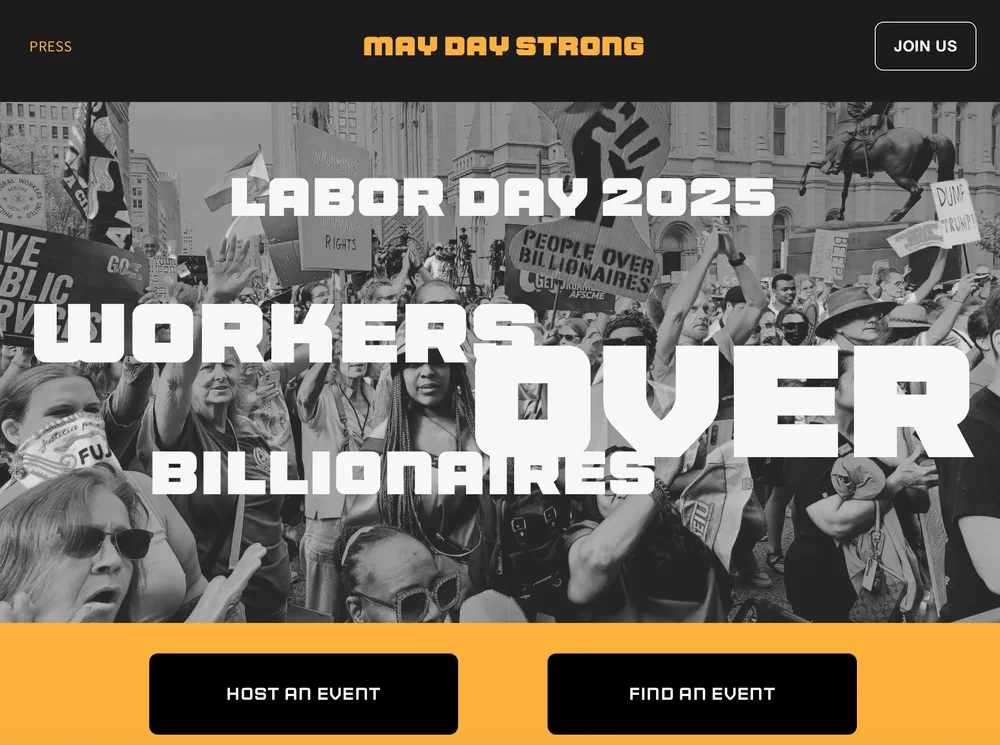
Everyone’s asking: how do we reverse the tide of fascism? One of the most important ways is to get into the streets with as many other people as we can turn out. With a little luck and your help, that’s about to happen on Monday, September 1, Labor Day.
An anti-fascist movement has been getting its act together, albeit in a somewhat lumbering fashion. DSA members in coalition with other community groups in California and elsewhere are showing up to protect immigrants from kidnapping by Trump’s secret police. Discussions are taking place among local elected officials and community coalitions to convince local law enforcement to refuse cooperation with the cruel, inhumane and often violent actions of ICE. Many people are leading or attending trainings on non-violent direct action, safe participation in demonstrations, and preparing for the 2026 elections.
Delegates to California DSA state council at its meeting on Saturday August 23 voted to endorse the off-year special election put in place by California governor Gavin Newsom and the state legislature, with Proposition 50, a statewide ballot initiative coming up this November 4. Devised in response to the actions of the Texas legislature to gerrymander its districts and elect five more Republican representatives to Congress, California’s state elected representatives have decided to fight fire with fire. [See article elsewhere in this issue.]
Actions like these, along with many others, are necessary types of work in building the anti-fascist movement. But for the coming week one item should be at the very top of our to do list: planning to come out on the streets on Labor Day, and make it the biggest nationwide demonstration yet. The May Day Strong coalition effort has scheduled hundreds of events across the country behind the banner of “Workers Over Billionaires.”
Next offramp
DSA members have been helping to organize for the national days of anti-Trump action, adding their bodies to millions of others across the country at events such as “No Kings Day”, expressing the firm desire to take the next offramp from Trump’s Road to Fascist Hell.
Although Labor Day is better known for barbecues and consumer discounts than militant demonstrations of worker solidarity, that’s not the way the holiday started out. Signed into law by President Grover Cleveland in 1894, it was meant to intervene within a moment of peak industrial class struggle. By giving workers a paid day off, the capitalist class hoped to lead them to believe that U.S. society might have something to offer besides the points of National Guard bayonets during strikes, all too fresh in mind the year of the American Railway Union’s Pullman Strike.
Labor Day was offered as a less radical substitute for International Workers Day, held on May 1, the campaign for which had sparked the only national general strike in US history, but was bloodily repressed in Chicago and elsewhere in 1886. The past few years have seen a revival of interest within organized labor to mark May Day as a time for remembrance of class struggles of the past and preparing for those to come. May Day 2025 served as one of the big days of national demonstration against Trumpian fascism, and labor leaders are calling for Labor Day to function the same way.
Making the event especially significant this year is a growing understanding that it’s up to all of up to stop the steady erosion of democracy, and that we can use events like Labor Day as steppingstones to build toward a strong mass anti-fascist movement, and to aim high at May Day 2028, when we answer United Auto Workers president Shawn Fain’s call to leave work together and begin to take back some of the historic power that the working class lost during the long years of neoliberalism.
Click here or here to find Labor Day events near you. See you on the streets.


A Chapter Is (Re-) Born
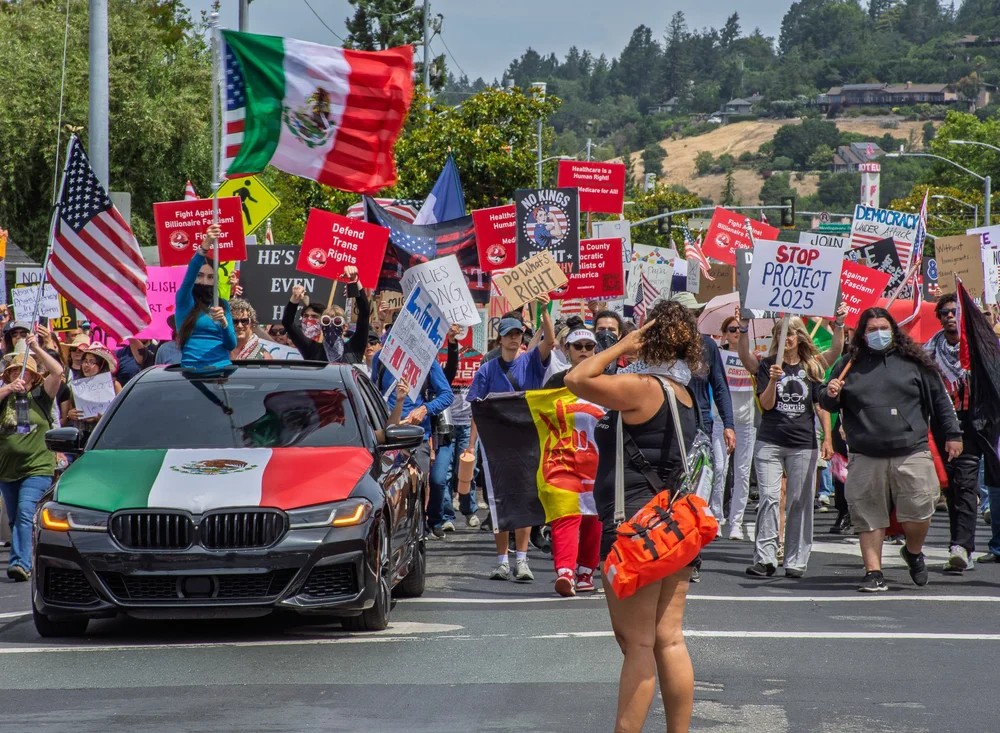
SoCoDSA March on 'No Kings or Their Clowns' Farmers Lane Santa Rosa June 14th
Marty Bennett interviews co-chair Jay Belmonarch of the brand new Sonoma chapter.
MB: Tell me about the origins of the new DSA chapter in Sonoma.
Jay Belmonarch: So right after Covid, I had inquired about joining the chapter that had previously existed here. But it had it already dissolved by that point. Then, last October, immediately before the last election, I got together with a couple of people to discuss forming a new chapter, and once we looked into it we were delighted to find that other groups of people had independently gone to submit the paperwork to start a new chapter. So needless to say, there was a lot of energy and enthusiasm behind it, since then.
I've been doing organizing and activism since I was a teenager. But I had no history with DSA before that. And actually, most of our core members are new to DSA. Many of them are new to Socialism. Many of them are new to organizing entirely. So starting from scratch presents difficulties. But I think it's an opportunity to build a movement that's truly integrated into the community, inherently, by its very origins. And personally, I believe that is the next step, on the way to mass movement of the working class.
MB: So most of those you're working with kind of came to DSA independently based upon their observations of DSA activities elsewhere in the country or the region.?
JB: Definitely. I mean Bernie Sanders, Alexandria Ocasio-Cortez, figures like Ilhan Omar, have brought more awareness to this type of politics, and it just has been shut out of our culture so completely for so long that a lot of people are discovering it for the very first time now.
MB: How are you going to address that internally? Are you planning, or are you engaged in political education?
JB: Yes, we have political education programs. We have reading groups. We're doing our first DSA 101 coming up in a couple of weeks.
MB: How many members would you say there are now, or members and supporters?
JB: Right now we are at 160 members, up from zero, like 6 months ago. We have made recruits at pretty much every event we have done so far. And we have put together a very diverse group, not only like in terms of identity and age, but also in a political perspective, and in the types of engagement they want with their community. And we encourage dual membership, especially in groups with a local focus, and that has been instrumental in making alliances that we expect to pay off. As the American fascist movement rolls on, increasingly we have to rely on solidarity.
MB: Dual memberships in terms of other progressive organizations?
Anything pro-democracy.
MB: Talk a little bit about the immediate and longer-term goals of this chapter. I presume for the last several months here you've just been getting organized as a chapter, and formally laying out the ground rules in the structure?
Jay: Yeah, we're trying to develop a sustainable organization that's going to be robust enough to be able to do a lot of things simultaneously. So the idea there is that members of our community can plug into our organizer network to make the changes that they want to in their neighborhoods and in their workplaces. We're focused on local impact as a strategy for building power and building reputation. The goal of that is to create alternative systems for our community to care for each other cooperatively. So that we don't have to rely on the state and on capitalist infrastructure that is so rapidly being degraded and stolen away from us. and even locally, you know, like municipal government or petit bourgeoisie, or whatever, they might agree with the concept of preventing illegal seizures or of liberation of marginalized peoples. But they won't risk their power to do it for us. We have to do it ourselves. So we're making an organization that is prepared for the long-term consequences of capitalist decay.
MB: And are you going to be engaging in workplace organizing?
JB: Yes, we are. Just starting to kind of enter that with some local union leadership having joined recently. So we'll be looking into that. And hopefully, we can work with other organizations locally, like Working Families Party.
MB: Where are people situated, and what type of workplaces?
JB: We have a lot of members in SEIU. Well, I mean, the County is the biggest employer in the area. We have a lot of members in unions in the healthcare industry and teachers.
MB: And in terms of the shorter-term goals of the chapter, are there specific campaigns that you've landed on?
JB: Yeah, we're focused on that sustainable growth of the organization and on maintaining the momentum of the resistance to this regime that we're seeing by providing a space for folks to be able to express their frustration through demonstrations, lobbying or just commiserating with like-minded people. We have set up committees for communication for elections. For mutual aid. We put on a variety of different activities. We mentioned political education: activities that can appeal to different people with different abilities and with different backgrounds. Do you want some examples of mutual aid?
MB: Yeah.
JB: Some of the things we're working on is food swaps, item swaps, cleaning up public spaces, skill share workshops for all different types of skills, repair and mending events and we're doing a lot of outreach at events that are implicitly nonpolitical community events, farmers markets, things like that.
MB: And is the intent that DSA in Sonoma County will become involved in local, if not state and national politics, as other DSA chapters have certainly in the East Bay?
JB: Absolutely. We are currently scouting for State Assembly, City Council, School boards. The thing is we refuse to do simple paper endorsements. So any candidate endorsed by the chapter is required to have a close public association with us.
MB: And then you will fully participate in their campaign?
JB: Anything less doesn't help us build our power. And we're even requiring that they become members. For Federal offices, we might be able to afford to be flexible on that. But we'll see how that those talks go. And you know, when it comes to representation in State legislatures and Congress, we're in kind of a unique position in Sonoma County. It’s a largely rural agricultural area that votes overwhelmingly for Democrats. There's a lot of money here. And as a result, there's entrenched institutional power. But so much of the population is working poor, and there's a long history of radical left politics in the area.
So I think when it comes to representation in the government we have unique needs. And also a unique advantage in the ability to demand responsiveness to those needs. On the kind of radical history point, our logo and mascot is a chicken, which is a reference to one of the earliest settler communities in this area was a chicken raising commune formed by Eastern European Jewish Communists. You know, we also have a lot of old school hippies around here, and these sorts of liberatory movements have been dormant for like generations. And it's past time that an updated, more useful version was revived. Something capable of delivering material gains for the working class.
MB: Of course there's a famous book called Comrades and Chicken Ranchers, by Kenneth Kann, which you probably looked at that chronicles that history which, indeed, goes way back to the twenties in this county.
JB: And it's so important, too. You know that we're in a position where we're advocating for the proletariat, but also the precariat, and, the importance of agriculture and the housing crisis together, makes that very important.
MB: Yeah, and, about two in five workers in this county are working poor. And we've had a long history of living wage and minimum wage campaigns in an attempt to raise the wage floor. And we've had multiple organizing drives, particularly in hospitality and waste management amongst low wage workers. So there's quite a history of particularly struggles for economic and social justice to be built upon in this county. But you're going to be doing your own endorsement process.
JB: That's right.
MB: But you do plan to be involved, certainly in local, if not state elections.
JB: Yes, we're taking an all or nothing approach. The idea is that if we can throw our weight behind somebody, they need to be there for us. So that we're a real constituency at that point. We want to build those relationships on that mutual basis.
MB: Tell me what role you perceive that DSA is going to play in building an anti-fascist united front in the county.
JB: Yeah, this county is full of people who are already doing good work. So we want our club to serve as like a platform for all types of pro-democracy efforts. We want to be the definitive hub of organizing in the county where we can draw upon resources and knowledge grounded in Socialist principles of DSA, and to be able to make a material impact on the area and to deepen left unity. We've been central to the new coalitions that have formed around anti-fascist action in the area, groups for the demonstrations May Day and Labor day groupings designed to bring the local Democratic Party closer to leftist organizing. And actually, right now, we're acting as a sort of a diplomatic corps, mediating strategy-disagreement between the more, I don't know, anarchistic and more conservative groups doing left organizing in the area. And we're well set up to function as a bridge between the different types of progressive organizations.
JB: And I I've been involved in this work since, like Occupy Wall Street, basically. And this is the first time that I've seen like a mass shift towards a more radical outlook. Or maybe radical, is not even the right word. But like we're seeing more and more people, recognizing that the struggles for liberation are all one and the same. We're seeing people who for decades understood the political as being a, you know once every four years, news-binging exercise, for the first time recognizing that their workplace is political, their housing is political, their childcare, their health care, their education is political. That violence abroad and kleptocracy at home are simply different aspects of the class war. And importantly, they see that they have no one left to lobby, like it's only the impotence of the Democratic Party that has revealed it as a tool of capital to its ostensible constituency, who have been loyal to it, maybe since the Party had a real relationship to organized labor. So as folks realize that they do not have the influence that they thought they did on their representatives they’re searching for alternatives, and I think the only viable alternative is democratic Socialism.
MB: And how do people get in touch with you?
JB: We have a website, socoDSA.org, and we have a bi-monthly newsletter. We have a discord group, which is not restricted to members, and anyone who lives in Sonoma County will see us at pretty much any public events we can get to.
MB: And you have a social event once a month. Is that correct?
JB: We have a business meeting once a month, and we have a more social, casual sort of get to know you meeting as well. So for this next one that'll be rolled into our first DSA 101.


National DSA Convention Report-Back
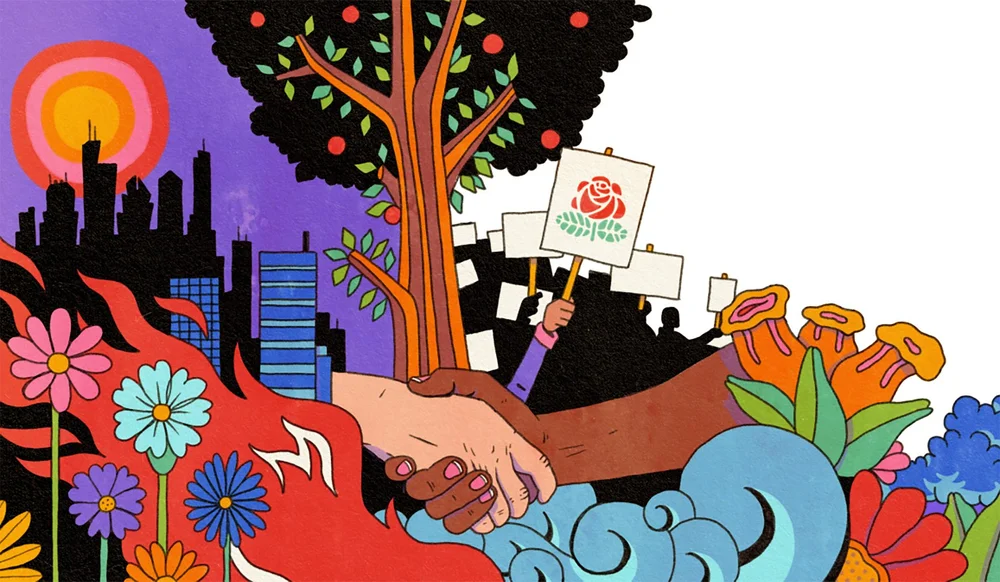
Earlier this month, delegates elected at-large or from chapters in California joined nearly 1,500 delegates from across the country in Chicago for the 2025 National Convention, the highest decision-making body of our organization. The convention takes place every two years, and it is where DSA debates priorities, amends its structure, and elects our national leadership.
Delegates spend full days moving through Robert’s Rules of Order, debating resolutions, and taking votes that will shape DSA’s work for the next two years. That process can be tense, procedural, and exhausting, particularly when the issues being debated are heavily internal. But it is also deeply inspiring: gatherings of over a thousand committed socialists in a single location are a rare occurrence in American history and an experience to be treasured. Perhaps the high point of the weekend came when Congresswoman Rashida Tlaib, herself an active member of Detroit DSA, delivered a keynote address that ended with the entire hall chanting “Free, Free Palestine!”
Over the course of three days, delegates considered 59 resolutions and major amendments, with another 45 qualifying but not reached in time. The convention expanded the National Political Committee (NPC) from 18 to 27 members, four of whom are from California. The NPC guides the organization between conventions, and the expansion was passed as a part of a package of reforms offered by the national “Democracy Commission”, which was renewed for the next two years. Those will now be taken up by the new NPC.
External Facing Priorities
The vast majority of external priorities coming out of convention were established in a single vote on the consent agenda, and thus didn’t receive separate debate. This is a double-edged sword. On the one hand, it saved time and demonstrated there is broad, near-unanimous support across the organization for these political priorities. On the other hand, it meant that these priorities were not top of mind coming out of convention, and contributed to the convention agenda overall feeling very internally-focused, with limited discussion of external political conditions and strategy. It will now be the responsibility of the newly elected NPC and DSA’s existing national committees and commissions to launch and drive enthusiasm and engagement in these big national campaigns, since they will not be top of mind for delegates or observers coming out of the convention, who are largely instead thinking about the internal contested debates as the convention’s primary takeaways.
Adopted priorities included:
Build Socialism, Defeat Trump, committed to fighting Trumpism as an existential threat to working-class power.
Support for Amazon Workers, committing DSA to supporting workers organizing against Amazon.
Towards a May Day 2028, laying the groundwork for a unified, class-conscious campaign that could help make a 2028 general strike a reality, following calls by UAW president Shawn Fain.
Support Immigrants and Fighting ICE, prioritizing DSA’s commitment to defending immigrants against deportation and state repression.
Palestine Solidarity, affirming that DSA “understands our primary responsibility as a US based organization in the heart of empire is to force our government and institutions to end their complicity through boycotts, divestments, and sanctions.” This commitment was further strengthened further in the final session, when delegates passed a resolution for “Labor for an Arms Embargo,” committing DSA to work with unions toward cutting off U.S. military aid to Israel.
Two major priorities from the last convention — a national campaign for Trans Rights and Bodily Autonomy and a campaign for a Green New Deal—were scheduled too late on the agenda to be debated. A motion to move them up for consideration narrowly failed, leaving them to be taken up by the NPC.
Internal Structure Debates
The vast majority of resolutions and contested votes were fairly internally focused, looking especially at the way DSA is internally structured and the way we budget. I want to highlight two key internal votes:
One Member, One Vote (1M1V): Multiple proposals were offered, to allow all members to directly vote on electing the NPC and on national endorsements for federal candidates. 1M1V for NPC elections fell short, with 40% in favor (60% required). A second proposal for members to vote on federal endorsements was ruled out of order by the chair and never voted on, leaving all endorsement decisions in the hands of the NPC.
Anti-Zionist Resolution: versions of this resolution have been a long-running debate within DSA. Proponents have argued that DSA’s pre-2016 history in which the organization held support for Labor Zionism, in addition to votes from DSA-supported congresspeople like Jamaal Bowman and AOC in favor of funding Israel’s Iron Dome, required DSA to raise its standards for members wavering on support for Palestine. Opponents argued that the resolution undermined a unified, external facing strategy as defined in coalition with the BDS National Congress, and that the resolution’s focus on identifying Zionist sympathies in members as expulsion-worthy offences was sectarian and overly internally focused. The resolution passed with 56% in favor.
Electoral Strategy
Finally, the convention passed several refinements and continuing commitments to DSA’s national electoral strategy. In particular::
Discouraging Paper Endorsements: Chapters are discouraged from issuing endorsements without committing resources to meaningful campaigns.
Encouraging DSA to prioritize “cadre candidates”, defined as members with significant experience as activists and organizers within DSA, the labor movement, and aligned organizations, as well as “labor candidates”, defined as candidates who are both rank and file labor leaders and self-identified democratic socialists, with DSA-LA’s Hugo Soto-Martinez and NYC-DSA’s Claire Valdez listed as examples of this type of candidate.
Beyond the Democratic Party: A new subcommittee will explore experiments with running socialists outside the Democratic Party, either on an independent ballot line or in non-partisan races.
Running a candidate for the 2028 Presidential Election: DSA will join coalitions to identify a candidate who can represent the labor-left in the next Democratic presidential primary. An amendment that would have oriented this search towards running as a third-party candidate failed, and the original resolution calls for identifying a “Bernie-style” candidate who can run as a labor leftist in the Democratic primary.


Meet Your 2025-26 CA DSA State Committee!
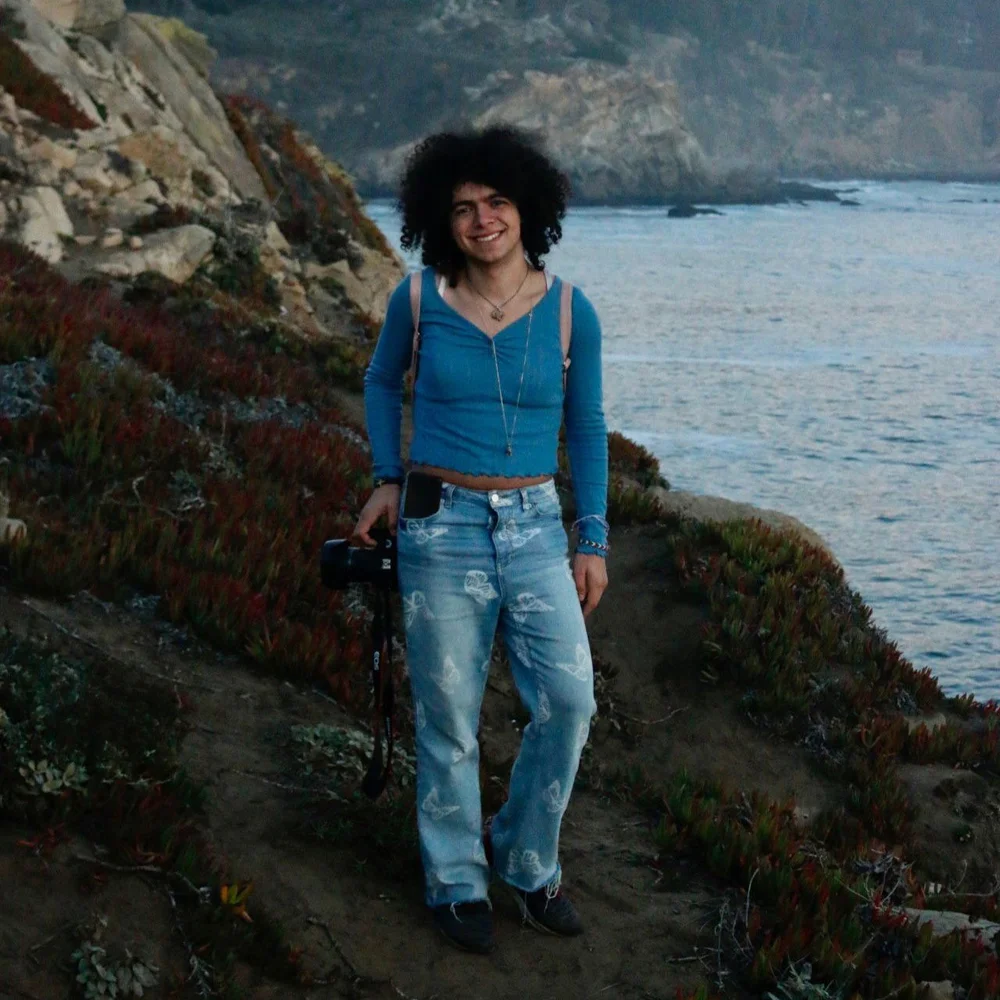
Nickan F
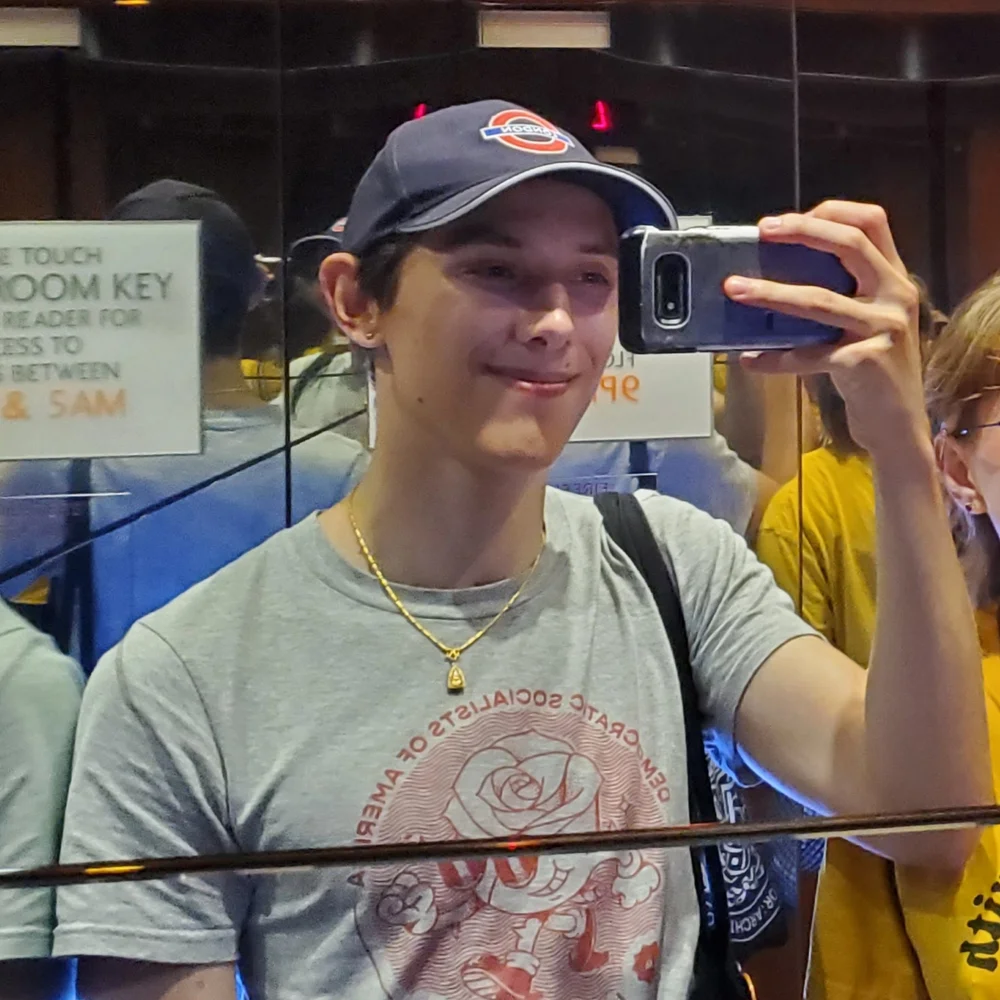
William P
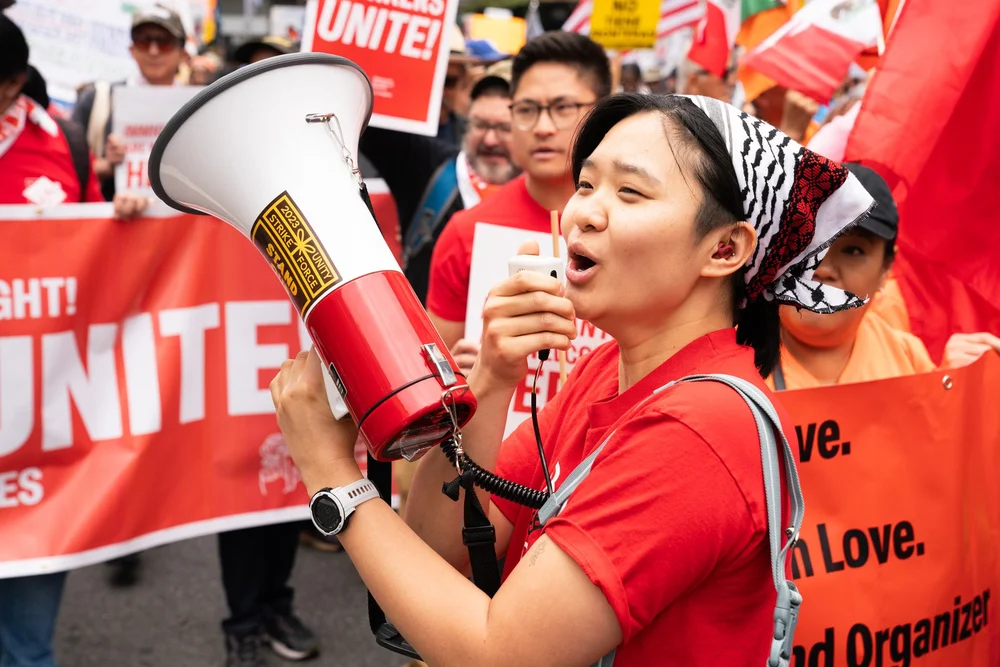
Jules Y
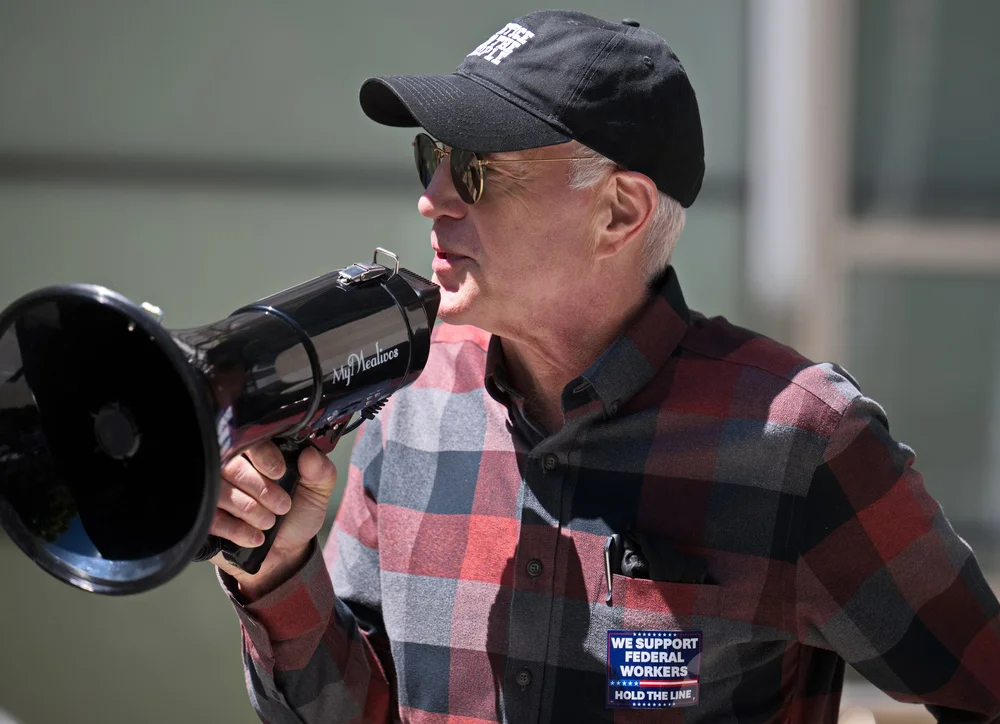
Michael L
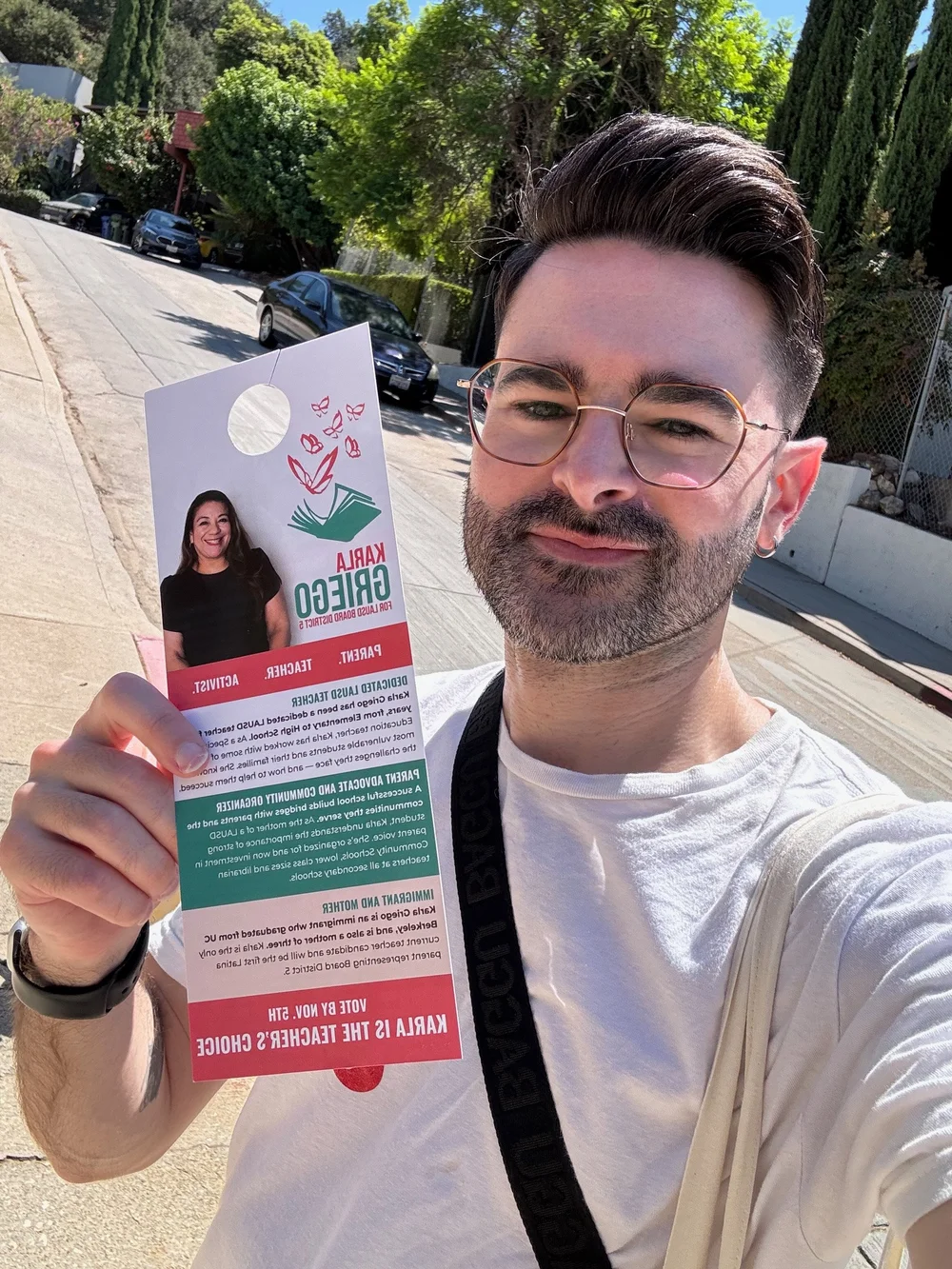
Paul Z
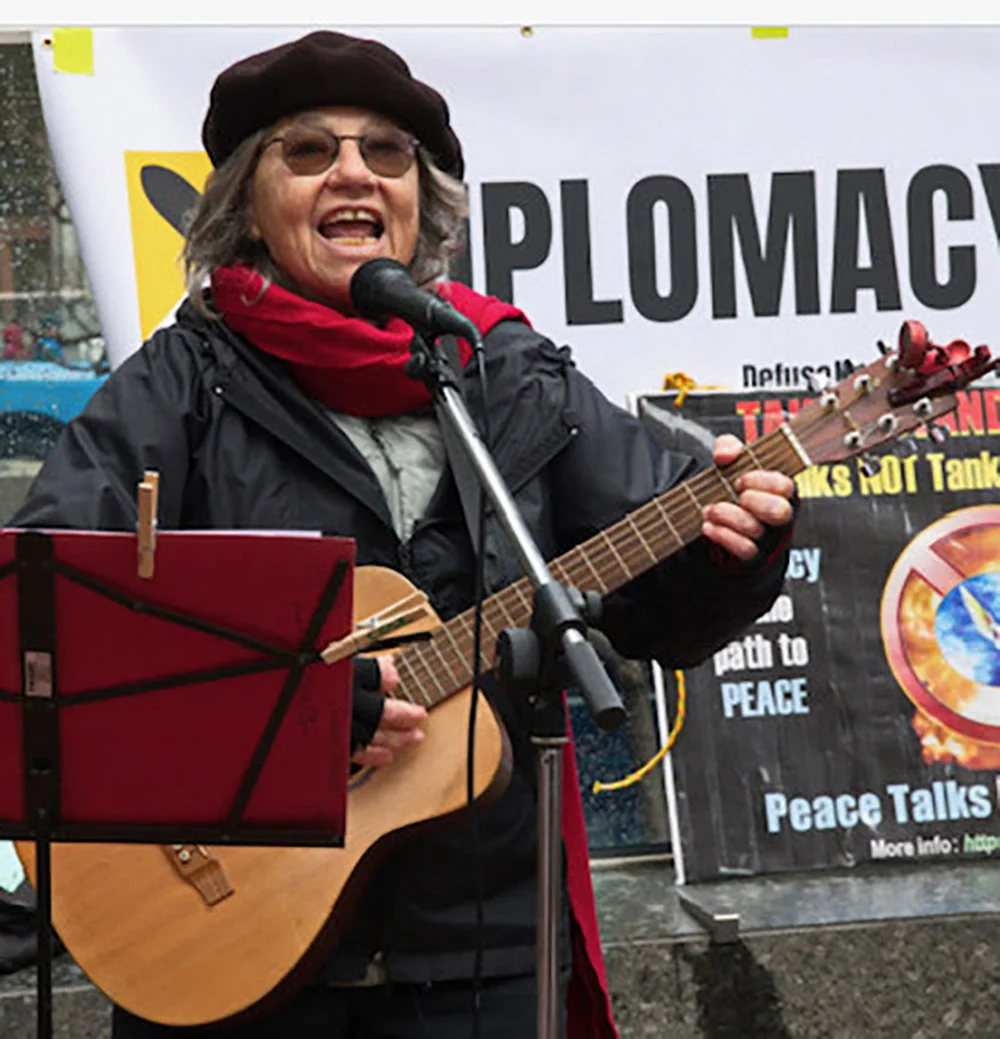
Bonnie L
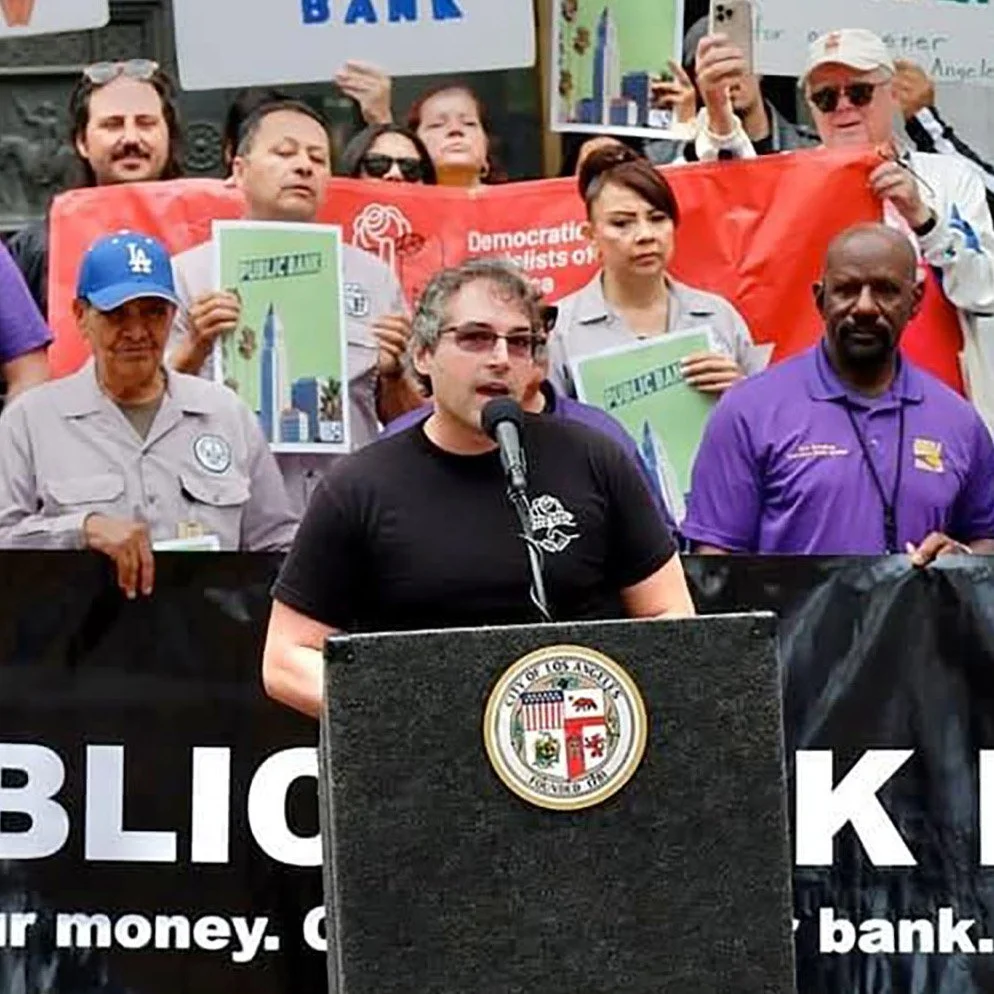
Mark G

Our seven-member California DSA State Committee, elected last month by State Council delegates, is responsible for organizing and steering the statewide organization between Council meetings. We’re a diverse set of organizers from up and down California, and we’re excited to be shepherding California DSA for the next year! Amid Trump’s fascist attacks on immigrants, the LGBTQ+ community, and the working class writ large, we're committed to steering an organization that is an active part in the struggle against his administration and to building an alternative vision for California.
Introducing our State Committee members:
Michael L (he/him)
Michael has been participating in EBDSA since 2017 in Medicare for All, labor solidarity and electoral organizing. He is active in the chapter’s priority campaign, ‘Fighting Oligarchy: Support Federal Workers’. He worked for the California Nurses Association//NNU for 25 years and has been a member of DSA since 1982.
William P (he/him)
William has been in DSA since 2021 and has canvassed in every election cycle since 2018. While at college, he co-founded a YDSA chapter that participated in a push to get the college to divest from Israel. He is currently a member of DSA-LA.
Jules Y (they/them)
Jules has been a member of DSA-LA for three years. They have been a labor and community organizer since organizing with dining hall workers to win a union at their university in 2018. This is Jules’s second term as Secretary on the State Committee.
Nickan F (she/her)
Nickan has been a DSA member for seven years and has served on the State Committee since 2023. She is most active in electoral organizing, having led the electoral committees of both East Bay DSA and CA DSA, and has worked on and volunteered for numerous campaigns.
Mark G (they/he)
Mark has been a member of DSA-LA for eight years, and serves as its Recording Secretary and co-chair of its campaign for stronger rent control.
Bonnie L (she/her)
Bonnie has been an East Bay DSA member since 2017. She was a co-founder of the chapter Climate & Environmental Justice Caucus and currently serves as Climate Action Committee and Boycott Chevron Campaign co-chair. She is a member of the American Federation of Musicians Local 1000.
Paul Z (he/him)
Paul is currently serving as the organization's Communications Director and is a member of DSA Los Angeles, where he serves as one of the Eastside Branch Coordinators. Since joining DSA in 2020, Paul has been active in many electoral campaigns and specializes in design and visual communications at the local, state, and national levels.

Your National Political Committee newsletter — Ideas into Action
Enjoy your August National Political Committee (NPC) newsletter! Our NPC is an elected 27-person body (including two YDSA members who share a vote) which functions as the board of directors of DSA. This month, you can welcome the new NPC, watch Rep. Rashida Tlaib’s electrifying speech, check out the Convention results, and get involved in DSA work!
And to make sure you get our newsletters in your inbox, sign up here! Each one features action alerts, upcoming events, political education, and more.
First off, we’d like to send a warm hello and gratitude to you for trusting us to be your national co-chairs for the next two years. This is a critical time for DSA, as we face down increasing fascism at home, militarism abroad, and the ticking clock of climate catastrophe. But we also continue to ride a wave of sustained membership growth, an increase in new DSA chapters and organizing committees, electoral wins, labor movement solidarity, and a general mood of excitement about the possibility of a democratic socialist future, one in which no one profits from the exploitation of another person. We are committed to working together alongside you all to level up DSA’s capacity, strength, and clarity of purpose as we build our fighting organization into the mass party that the moment demands.

We’d also like to congratulate our new fellow National Political Committee members, who were elected at our 2025 Convention earlier this month to a newly expanded NPC. They are:
- Christian A. (Long Island DSA)
- Eleanor B. (NYC-DSA)
- Hayley B.B. (Portland DSA)
- Jeremy C. (NYC-DSA)
- Cliff C. (Orlando DSA)
- Sidney C.W. (NYC-DSA)
- Kareem E. (NYC-DSA)
- Cerena E. (Houston DSA)
- Abdullah F. (DSA-LA)
- Frances G. (DSA-LA)
- Ahmed H. (NYC-DSA)
- David J. (NYC-DSA)
- John L. (New Orleans DSA)
- Francesca M. (Connecticut DSA)
- Luisa M. (Portland DSA)
- Sarah M. (Portland DSA)
- Clayton R. (DSA-LA)
- Katie S. (Ithaca DSA)
- Ella T. (Seattle DSA)
- Andrew T. (Denver DSA)
- Cara T. (Metro Detroit DSA)
- Amy W. (Seattle DSA)
- Hazel W. (DSA SF)
Congratulations to all and we look forward to working with you!
The NPC elections were certainly not the only exciting thing that happened at Convention. Over 1300 delegate members (and hundreds of alternates) also committed to expanding our socialist electoral program, building out our Palestinian solidarity and internationalist organizing work, deepening our participation in the labor movement and toward an arms embargo against Israel, fighting fascist attacks on immigrants and standing up against state repression from ICE, preparing for May Day 2028, building worker power against Amazon, uniting labor and the left to run a socialist for president in 2028, and so much more!
We were honored by a fiery keynote speech by Rep. Rashida Tlaib, who grounded us in our place in American history and exhorted us to “take this country back for our working families and defeat these pathetic, cowardly, hateful fascists. We’re going to win because we don’t have any other options, and yes, we are going to free Palestine. They don’t have any other choice. Our movement isn’t going anywhere, and we’re just getting started.” This was one of our most mediagenic conventions yet, with new media and streamers like Hasan Piker observing and engaging in real time, and mainstream outlets like The Guardian noting the energy of our winning streak and Rolling Stone going in-depth on how we are preparing to seize the political moment.
We also had dozens of volunteers helping staff and elected leadership with press, tech, security, and more, in a real show of collective organizing strength. And even members who did not attend were able to tune in for deliberation and to watch our first-ever Cross-Organizational Political Exchange with socialist parties from around the world and labor unions and social movement organizations from around the country — over 1400 unique viewers watched the Convention livestream online, averaging about 200 at any given time. You can read the preliminary results here, and we will be keeping you updated as the NPC considers the overflow items over the next few months.
There’s a real excitement that comes from charting a path forward, and now it’s time to knuckle down and get to work on putting these ideas into action. If you need a bit more inspiration, though, here are some things you can sign up for right now:
- Solidarity Dues Phonebank (Sunday 8/31 at 4pm ET/3pm CT/2pm MT/1pm PT): Member dues are DSA’s primary source of income and help create some of the amazing tools and resources that DSA offers. Help us call through folks and make the hard ask: can we count on you to switch to Solidarity Dues? It’s a friendly list of fellow DSA members, so these are fantastic folks to practice those organizing conversations with.
- Fight Fascism, Build Socialism (Tuesday 9/2 at 7pm ET/6pm CT/5pm MT/4pm PT): The chaos of this second Trump administration is an onslaught meant to overwhelm us and make us feel powerless. But we are not powerless when we’re organized, and we’re still fighting for someone we don’t know. Join us on this call featuring how DSA members across the country are fighting back! After Labor Day, it’s time to take the fascists back to school.
- YDSA’s Fall Drive Launch Call (Tuesday 9/2 at 8pm ET/7pm CT/6pm MT/5pm PT): At campuses all over the United States, YDSA chapters are continuing their fights for ambitious demands around sanctuary campuses, worker rights, divesting from the genocide in Palestine, and so much more! To kick off this semester, we’re gathering to hear from successful chapters around the country about what they’re working on, how they plan to grow this fall, and what you can do to see the same impact locally!
- September Leadership Intensive (Saturday 9/6 and Sunday 9/7 starting at 1pm ET/12pm CT/11am MT/10am PT): Ready to take the step into chapter or committee leadership? The Leadership Intensive is the most comprehensive training that DSA provides (it’s 2 days long!) for folks who are ready to take on leadership work, and will get you familiar with everything from tech tools to the theoretical basis of the democratic project.
- Emergency Tenant Organizing Committee 2025 Fall Training Series (Saturdays in September beginning Saturday 9/6 at 2pm ET/1pm CT/12pm MT/11am PT): The Housing Justice Commission’s summer Emergency Tenant Organizing Committee (ETOC) cohort is now accepting prospective tenant organizers. ETOC is an initiative to promote the formation of militant tenant unions through tenant-to-tenant training and instruction. In this series, you’ll learn the fundamentals of tenant organizing on a citywide or regional scale.
- National DSA 101 (Sunday 9/14 at 2pm ET/1pm CT/12pm MT/11am PT): Whether you’re just now becoming a member or you’re a longtime member interested in doing more DSA work, come to this program to get a birds-eye view of what we’re up to.
- Socialist Cash Takes Out Capitalist Trash Phonebanks (various times/dates): Help support our nationally-endorsed slate by spreading the good word about (and asking comrades for donations for) our candidates in Detroit, Jersey City, Atlanta, Renton, Tacoma, and Ithaca, all of whom are fighting like hell to win and build power at the municipal level.
And that just scratches the surface of upcoming opportunities! Keep an eye out for new opportunities — we’ll keep sending them your way.
In the meantime, solidarity to you and we can’t wait to see you at an event soon!
In struggle,
Megan Romer and Ashik Siddique
DSA National Co-Chairs
The post Your National Political Committee newsletter — Ideas into Action appeared first on Democratic Socialists of America (DSA).
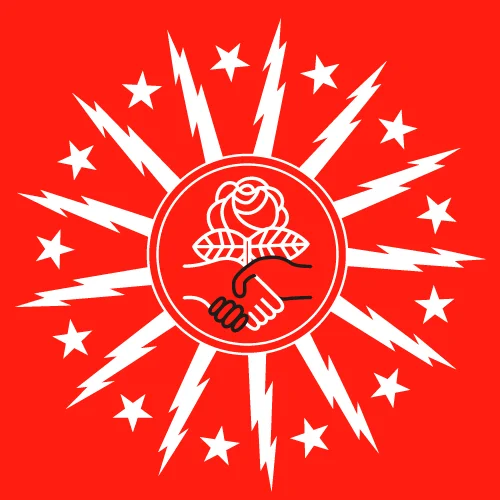

Buffalo DSA Urges Reconsideration of Broadway-Fillmore Police Training Facility
Since March 2025, Buffalo DSA has endorsed LOLA’s Communities Not Cops campaign, with overwhelming support from our general membership. As this project begins to receive the citywide attention and debate it deserves, the Buffalo DSA Steering Committee reaffirms our support of efforts to educate and agitate against a police training facility and shooting range on Paderewski Drive. We also urge all members of Buffalo DSA to follow LOLA’s calls to action re: demanding Common Councilmembers vote “NO” on the rezoning of the Paderewski Drive location, as listed on their Instagram page.
The creation of a police training facility increases the Buffalo Police Department’s capacity for targeting working-class Buffalonians through violent interventions, especially those in minority ethnic groups and within our city’s poorest communities. This is especially heinous considering Paderewski Drive was once home to a community center; we are disappointed to see the city invest in more militarized policing, rather than restoring a public civic space. This is completely counter to the just city we deserve – not just for those in the immediate neighborhood, but for working class communities citywide. We have been disappointed by the limited scope of debate around this project to this point, which suggests that only the immediate neighborhood will be impacted by this facility. We encourage comrades and neighbors to consider the larger ramifications of a police training facility of this kind.
Said limited scope of debate stems from a source actively collaborating with the Buffalo Police Department to push this project through. The Central Terminal Neighborhood Association is claiming a mandate to speak for the entire area, despite reports that opposition to the project has now spread beyond LOLA’s initial campaign, and to Broadway-Fillmore community members who have just learned about the project relative to its progress. Neighbors deserve fair representation of the project to them, rather than vague promises of a “community benefits agreement” with BPD – the details of which include only surface-level commitments toward “youth programs” in part of the facility and keeping neighborhood trees intact. We also condemn undignified smear tactics, printed or otherwise recorded publicly, that concerned citizens across Buffalo are only seeking cameras or clicks.
As the Common Council, the Buffalo Police Department, and other crucial city officials collude to advance this project via their Sep. 2 vote, we once again doubt their belief in democratic processes, and question the Central Terminal Neighborhood Association’s mandate to speak for the city on the matter.
Our chapter’s vision for demilitarized policing takes from the rich history of American socialism, notably from the legacy of American socialist Eugene V. Debs. Debs stated in 1918, after his conviction for violating the Sedition Act:
“While there is a lower class, I am in it, while there is a criminal element, I am of it, and while there is a soul in prison, I am not free.”
While we cannot speak for a long-deceased comrade, Debs’ rhetoric throughout his life demanded the liberation of the working class from oppression and tyranny. To aid and abet the tyranny of modern policing is antithetical to the American socialist tradition.
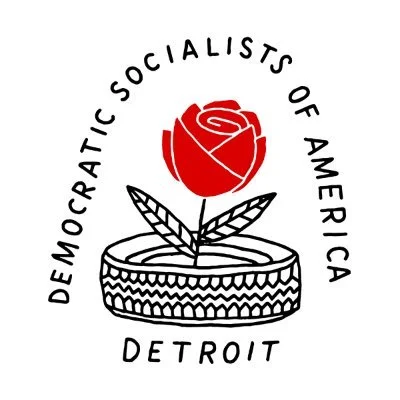

We Asked For Change And We Got It
By: Yash Khaleque
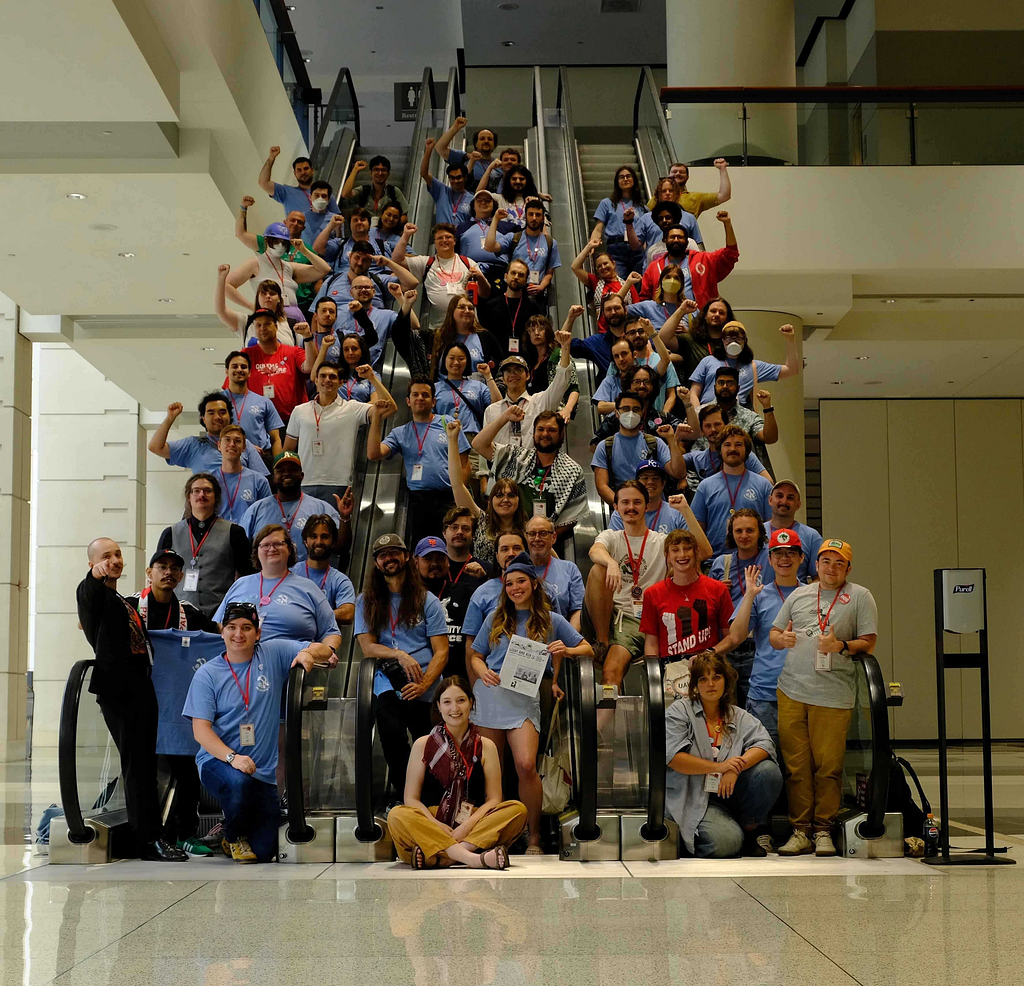
Theme song: Kino — Peremen
DSA National Conventions are a truly unique social phenomenon. Terminally online sickos swarm the streets of Chicago like an invasive species, sporting their red lanyards and esoteric emblems, chanting “Death, Death to the IDF” outside a fashion store turned nightclub. The Convention is a gathering of over a thousand influential organizers and thought leaders within our organization set towards the task of charting the course for the next two years. The energy of the room is excited and exuberant, ready to tackle whatever fresh hell the world has in store for us. It makes you feel like there are no obstacles the party cannot overcome, and that change is right around the corner.
Convention is a place where ideological caucuses, which are usually not impactful in day to day work, find themselves as the forefront institutions deciding the future of American socialism. They organize campaigns to lobby undecideds in their favor. Tables end up littered with the myriad literature that gets handed out. Tensions certainly rise over aggressive politicking, procedural nonsense, and decisive votes, but we often come out of the experience with greater respect and solidarity for our comrades across factional lines.
Perhaps it’s easier for victors of a political struggle to feel jovial about it. I write this as a member of the Marxist Unity Group (MUG), which accomplished nearly all of its strategic aims this year.
- The Light and Air publication continues to be unrivalled in print newsletters analyzing the previous day’s proceedings and upcoming votes. Not even the Trotskyists from Reform & Revolution (R&R) could match our paper game!
- We won 3 out of 3 National Political Committee seats we contested, and we assisted our R&R allies in scoring a seat as well.
- Won key policy votes, including the last second buzzer beater R07: “Principles of Party Building.”
The topic of Palestine featured heavily in this year’s convention, two years into the genocide in Gaza, and the proceedings were absolutely phenomenal. “A weapon is a weapon” said Rep. Rashida Tlaib at the plenary session, a clear attack against Rep. Alexandria Ocasio-Cortez’s vote for Iron Dome funding.
It’s been said you can differentiate between different types of communists by when they think the Russian Revolution failed. Similarly, one may identify tendencies based on when they soured on AOC. For me, it was when she voted for President Biden’s strikebreaking measures against railway workers after the 2023 derailment and environmental disaster in the prophetically named East Palestine, Ohio. This is not merely a fringe opinion — a resolution to censure AOC was agendized even before the Iron Dome incident.
While we ran out of time before this could be debated, the question of electoral discipline and renegades will be continuously prescient in our burgeoning party-like structure, especially as we assume executive office in NYC and Minneapolis in the coming months. It shows that victory alone is not enough, and that we need to understand what to do with it or else face disaster.
MUG advocates for a couple of principles on electoralism: A Strategy of Patience where we seek a majority in the legislature, or at least dominance in the streets, prior to taking executive office. We also back a Tribunes of the People model wherein electeds work to build the socialist movement as a whole rather than merely their influence in government. This means unconditionally supporting the people against injustice without making backroom deals for expedience or “pragmatism.”
The other bombshell on the topic was the passage of R22: “For a Fighting Anti-Zionist DSA,” which has been the cause of some charged discourse online. I’ll leave it to other articles to explain the mythbusting around this resolution in greater detail, but I will reiterate that it does not sanction mass purges of DSA, require un-endorsement of Zohran Mamdani, nor imply that nay voters are all Zionists. What struck me about this piece is that the failure of the 2023 version of the resolution at Convention caused the Palestinian Youth Movement (PYM) to issue an embargo against cooperation with DSA. Over the next two years, 50+ chapters representing about 40% of national membership worked to pass local versions of this to restore relations. With the culmination of this resolution as national policy, inshallah we can return to work with PYM and the rest of the movement.
What saddened me about moving to Detroit was that the metro’s status as the center of Arab American and Muslim life is not reflected in its DSA chapter. Back in Dallas, the YDSA and Students for Justice in Palestine ran thick as thieves, and the Anti-War Working Group did their all for international solidarity. In nearly a year of being in this chapter, not once have we done education on Palestine or made solidarity work a chapter priority. In the DSA 2.0 we’re inaugurating, I’m now confident we’ll find our way back to the righteous path.
And what is this new DSA? It is the internal and external recognition of DSA as its own thing and not merely a faction of liberals. Passing “Principles of Party Building” does not automatically conjure political independence and partyist structure into being. But rather it is a useful barometer for how the majority seeks to move and a benchmark for local and national bodies to meet. It must be stressed that political independence is more than whether the ballot line reads Democratic, Independent, or Socialist. It’s about whether we can formulate and execute action without reliance on state and capitalist institutions. As it stands, Detroit DSA is still dependent on the progressive blob/NGO complex for direction. We need to develop the desire to instigate against the ruling order on our own terms and learn to ditch the training wheels of the liberal coalition. This I believe is a growing conversation within the chapter that will become increasingly relevant as we head towards a national turning point in 2028.
It would not be wholly accurate to boast about a #MUGSWEEP without addressing a couple near misses that overperformed expectations in such a way that defeat actually stung. The first is R34-A01: “A Fighting Socialist Program for DSA,” an update and expansion to Workers Deserve More. The vision and objectives of the proposed program are too long to elucidate here and we recommend interested readers to refer to the Resolutions Compendium. A strong belief of mine is that the national program ought to be decided by the Convention. With the failure of this amendment, it will default to a Program Committee chosen by the NPC whose members are selected from national body leadership, general membership, and the NPC itself. What this means is that our program will be written bureaucratically and through horse trading in personnel selection. This centers politicking over actual politics. We would hope that Convention delegates would be the ones voting among a number of draft programs, but alas only MUG-R&R had the initiative to try to advance one.
A second failed item of note was CR10-A01: “A Partyist Labor Strategy.” It’s based on the idea that only an independent socialist party can provide the basis for an independent labor movement and effectively connect actions between the economic and political spheres. It’s the sense that we need a visible socialist nucleus in the unions to point out the failure and betrayal of the reformers (e.g. the Teamsters’ turn to the Republicans). A need for a partyist approach to labor was shown in the dissolution of the UAWD, a source of controversy in our chapter. As I am neither UAW nor an auto worker, I am ultimately dispositional on who’s right and wrong. But what I did find disconcerting is that DSA members were central figures on both sides of the split. An argument has been expressed that we should be free to act as we please outside of DSA. The problem with this line of thinking is that it shows outsiders the impression that DSA is an incoherent [dis]organization incapable of leadership.
More broadly, this touches on the topic of democratic centralism, a core advocacy of the authors’ vision of internal democracy. It’s best described as “diversity of thought, unity of action,” a middle ground between the “Tyranny of Structurelessness” that arises from laissez-faire governance and bureaucratic centralism, a leadership-centric “rule of experts.” It entails respect for the majoritarian decision while maintaining freedom to criticize it and organize for change. For example, many in New York spoke against endorsing Zohran for mayor, yet took action in key organizing roles anyway. Let’s work to build a culture of democratic discipline here as well.
I joined MUG right after the 2023 Convention. In high-level terms, MUG is a caucus that purports orthodox Marxism, democratic republicanism, and a practical approach to revolutionary ethos. What I found compelling about them was their grind in producing convention bulletin articles and the renowned 500-page MUG Reader, the mandatory study book for prospective members. It showed to me that this is a group that’s truly dedicated to learning from the successes and failures from the past, and that they seek to raise up quality membership rather than merely whip votes. The potency of our crew has been made evident in the ideas we’ve pushed into becoming DSA consensus: pursuit of programmatic unity (as opposed to ideological unity), the need for a democratic republic, and now partyism. Plus, our logo is super cool. And that’s what matters most, right?
DSA has come a long way since I joined it in October 2018. Gone are the days of looking towards Bernie Sanders’ next campaign as our savior. Gone are the stagnant doldrums of the Biden era. We asked for change, and we got it!
Bonus track: Utro v Tebe — Karl Marx
This article represents the opinion of the author and does not necessarily represent the views of The Detroit Socialist or Metro Detroit DSA as a whole.
We Asked For Change And We Got It was originally published in The Detroit Socialist on Medium, where people are continuing the conversation by highlighting and responding to this story.


Fear and Resolve: My Faith is in DSA
By: Micah J.
Reflecting on the 2025 DSA National Convention, I feel profound joy, excitement, angst, and trepidation. The theme of this convention was “Party Building,” and the debates and resolutions were primarily focused on preparing ourselves and our organization — our Party, if I may be so bold to say at this point — for the next decade. When reflecting on this convention, I am likewise reflecting on the past decade of the DSA (the birth and maturing of what many call the “new” DSA) and on my own life. Writing this in August 2025, I am 27 years old, turning 28 this coming January. I reached adulthood concurrently with the DSA renaissance; my political awakening was the 2016 election, in which I voted for the first time, casting my vote for Bernie Sanders in the Democratic Primary, and then refusing to vote for Hillary Clinton in the General Election.
I am seized with the joy, hope, and confidence in a better world, in a way typical of revolutionary socialists. I am likewise quick to sink into melancholy, despair, and bitterness at the state of the world, also in a way typical of revolutionary socialists. Therefore, as I reflect on this convention, I am simultaneously filled with pride in our organization, certainty in the righteousness of our cause, and assuredness in our inevitable victory, as well as with fear of our coming struggles, of the enemies we must overcome, and the possibility that — though the working class will someday triumph — we, as in the DSA, may lose. This is a possibility that all of us must honestly reckon with, and was the fate of nearly every liberatory organization (socialist, communist, progressive, or what have you) in history. This is not to say that we should approach our struggle fatalistically, with our eyes on our own destruction, as if it were a foregone inevitability, or even a purifying self-sacrifice (a la Jesus, Johnny Silverhand, or Macbeth — pick your favorite reference). It is however something that is occupying my thoughts. The ramifications of this past convention, particularly with the resolutions that were passed, mean an inevitable heightening of contradictions, both within our organization, as well as with how our organization relates to our society as a whole. We are far stronger after this convention than we were before it, and that is the point I will try to make in this piece. But as we become stronger, so do the challenges and enemies that we will have to face.
Before I plunge forward, I must make clear my own affiliations, as I was not a neutral party at this convention. I am a member of the Marxist Unity Group (MUG), and am a fervent partisan for Orthodox Marxism. I recognize and understand the central role of the mass socialist party in the revolutionary struggle. I dream of a socialist democratic republic, first in North America and then throughout the entire world, in which the working class will have taken its rightful seat as the ruling class. And I believe that the working class, by winning the battle for democracy and becoming the ruling class, will lead humanity towards a stateless, classless, moneyless society, in which the means of production are held in common and used for the benefit of all, towards a society in which human history will truly begin: communism.
The Anti-Zionist Resolution: Reification and Honesty
The first and most clear evidence of our organization’s maturation is the passing of Resolution 22, “For a Fighting Anti-Zionist DSA.” It is difficult to put into words the joy I felt seeing the adoption of this resolution. At long last, the Democratic Socialists of America has shed the last vestiges of labor Zionism that had so plagued it through much of the late 20th century. This is both its own qualitative, self-conscious step forward, as well as a natural, necessary advancement that was, frankly, a long time coming. I do not mean to imply that anti-Zionism is not already the hegemonic position within DSA, nor do I doubt the commitment of comrades who voted against this resolution towards Palestinian liberation (1). Rather, I liken this resolution to a person soberly reflecting on their past, realizing how far they have come, and that they are not the same person that they were only a handful of years previously. Having realized this, they then create a new path forward for themselves.
As I already stated, the underlying principles of this resolution are hardly controversial. Rare is the DSA member who in 2025 would say that they support Israel’s right to defend itself, or who are under the delusion of equating anti-Zionism with anti-Semitism, or who does not believe that the cause of Palestinian liberation is currently the nexus of the global anti-imperial struggle. Such views, though they may have been more common five years ago, or ten years ago, or certainly 20 years ago, are now rejected automatically by the newest member walking into their first meeting. What was missing was taking these principles and turning them towards programmatic ends. What does it mean for DSA to be an anti-Zionist organization? Is it enough for its members to merely chant “Free Free Palestine!”? This resolution seeks to answer that question, ensuring that DSA is firmly anti-Zionist, not just in inclination or rhetoric, but in actual practice.
Much of the content of this resolution is dedicated towards laying out groups that we must ally with, and campaigns we must join in, and the principles for future alliances, campaigns, and coalitions. These are all, to a group, chosen for their committed anti-imperialist actions and stances. The fact that these principles have been set forth, and that these groups (such as Stop Fueling Genocide, the Palestinian Youth Movement, the Palestine Solidarity Working Group’s No Appetite for Apartheid campaign, etc.) have been chosen by us to ally with, are natural consequences of the principles that all of us in DSA (and certainly all of us in Metro Detroit) hold proudly.
In light of our shared principles, we have through this resolution finally set down on paper something that we all understand and already believe: that there is absolutely no room for Zionism within DSA. Just as we will have no truck with those who say that trans liberation is a distraction from workers’ rights (as if trans rights are not workers’ rights), we will likewise not tolerate Zionism, either in behavior or in rhetoric. This resolution therefore stipulates that any member who can be shown to “have consistently and publicly opposed BDS and the Palestinian cause,” shown to be “currently affiliated with the Israeli government or any Zionist lobby,” or shown to “have knowingly provided material aid to Israel” is “thereby committing an expellable offense.” I am proud to be a member of an organization that takes such a firm, righteous stance — a stance that is a natural application of the principles of the vast majority of the national membership, and of every person within the Metro Detroit chapter.
(1) Almost every single person who thinks this way has already quit the organization, especially since the beginning of the Israeli offensive two years ago, when DSA held strong to its professed anti-Zionist stance.
Building the Party, and the Terms of our Struggle
One could say, quite honestly and accurately, that every resolution, every amendment, and every debate slot contained within it implications for what this coming “decade of party building” would be. The full scope of all of this will be elaborated in the countless reports and reflections that are even now being written. I want to home in on one particular resolution, which was, in fact, the last resolution that was debated and voted on in the entire convention — just barely squeaking in after a great deal of procedural obstruction throughout the weekend had caused massive delays in the agenda. This was the succinctly named “Principles of Party Building.” The purpose of this resolution was to go beyond implications and inferences for what the formal structure-building principles of our party may be, and states in clear, no-uncertain terms what it means for us, for DSA, to be a party in a qualified sense.
The resolution acknowledges that DSA does de facto already operate as a party, from a certain point of view. We already have a culture of political independence, we already run candidates under a DSA platform (though the explicit party line displayed on ballots still eludes us), and we are already talked about by the bourgeois press as being our own thing, distinct from all other political formations, the Democratic Party in particular. This last point especially is something that deserves its own careful appreciation. We are long past the days in which DSA and Democratic Socialists are considered a “progressive wing” of the Democratic Party, or even a fringe of the Democratic Party. Observers watching from the outside, even as the convention was ongoing, spoke of us as the center of a new type of movement. Now, to be sure, a curious liberal watching from the sidelines will have neither the understanding nor the vocabulary to describe our movement, but they can still see and feel that something is different about us.
Thus enters the “Principles of Party Building” resolution, and we have before our eyes the language that liberals lack, which we may use to describe ourselves, our Party, and our movement. In Point 1, we have the motivation for a revolutionary party program, the purpose of which would be to orient our party towards the goal of the democratic socialist republic, in which the working class holds political hegemony, acting, for the first time in American history, as the ruling class. Points 2–4 state the principles for our internal structure. We are to be a maximally democratic organization, in which decisions are made from the bottom up at general meetings, chapter conventions, and national conventions. Members shall be free to associate and group together in factions with distinct political lines, and thereby contribute constructively to the direction of our party. A diversity of views will be protected, as long as the promoters of that line are acting honestly and openly, without contradicting fundamental socialist principles, and with the understanding that after an honest debate and a vote is taken, all participants in that debate and vote will accept the results as legitimate and valid, and will be eager to carry out the decisions of the body. We most directly see this in Point 2, where we read, “Members must be able to critique the party’s program and organize to change it, as long as they are willing to accept fighting for it as the democratically-determined expression of DSA’s goals.” This is the essence of democratic centralism.
Points 5–8 state the premise and means for our operation within the current bourgeois state. We acknowledge the unfortunate reality that when running a candidate for office, we by sheer necessity will in nearly every instance be forced to run the candidate on the Democratic ballot. This is purely a tactical question, and must not be mistaken for any idea of reforming or realigning the Democratic Party. We thus are doubly compelled to build our own robust internal infrastructure and hold steadfast to our principles in order to avoid getting swallowed up in the whirlpool of the Democratic kraken. Our tactic is “party surrogate,” but always with the commitment to our own internal democracy, and with the long-term view of total opposition to the Democratic Party, the capitalist state, and all other bourgeois institutions. Properly stated, then, our formula must be “party surrogate in form, clean break in content.”
And finally, Points 9 and 10 state that though our current front of struggle is within the confines of the United States, our true fight is global, international. We are tasked to, even now, today, begin making connections and finding points of unity with comrades across the globe. We in the United States must make double — triple — sure of this, as we shoulder the burden of working within the core of the global imperialist machine. Just as the American state projects its influence throughout the globe, we must in turn form relationships and alliances with genuine socialist projects throughout the world. At convention, we heard from comrades from other nations, and in particular we received video messages from Cuba and from Jeremy Corbyn in the UK. I wept listening to the message of solidarity from our comrades to the south, in the only socialist republic in the western hemisphere, that is so cruelly kept under the boot of American imperialism. Our efforts in building solidarity with comrades in other nations must necessarily lead to the formation of a new International, through which we may struggle on every front in the global fight against capitalism. I dream of the foundation of this new International, and hope that this International will be the one that finally unites the human race.
Until the Final Conflict
And now the responsibility is ours, Motor City comrades, to take this convention, with its decisions and consequences, and march on. I will not lie to you all and withhold the fact that part of my jubilance in writing this article about this convention is because I was on the winning side of nearly all of the most consequential decisions. It is not because of any special insight or personal brilliance that I and my comrades in MUG achieved nearly all of our goals for this convention. It is rather because principled, unapologetic, proud Orthodox Marxism is the correct line. It was correct in 1871, correct in 1917, and it is correct today in 2025. Our organization, our Party, is maturing, and is therefore finding it necessary to ground itself in the proud tradition of historical Marxism. There is no shortcut on the road to power, no weird trick through which we can avoid the historical necessity of an independent mass socialist party. It is this line that I am convinced of, and because of it, I have absolute faith in DSA, and in the international working class.
This article represents the opinion of the author and does not necessarily represent the views of The Detroit Socialist or Metro Detroit DSA as a whole.
Fear and Resolve: My Faith is in DSA was originally published in The Detroit Socialist on Medium, where people are continuing the conversation by highlighting and responding to this story.


Reflecting on the 2025 National Convention
We had an absolutely fantastic time with our comrades at the 2025 DSA National Convention! Many of our Steering Committee members were serving as delegates for their chapters so we were able to catch up in person – some of us meeting IRL for the first time!
And of course – we have news to share with you regarding the direction of DSA’s national electoral work as determined by Convention as well as updates from our Socialist Cash Takes Out Capitalist Trash fundraising project!


For the NEC, Convention kicked off with us hosting an electoral-themed social on Thursday night, where participants were invited to make buttons of their favorite nationally-endorsed DSA candidates and partook in a get-to-know-you BINGO as they mingled with our candidates and electeds. The activity prompted people to meet comrades from chapters running campaigns with national endorsement, socialize with people who serve on their chapter’s electoral working groups, and connect with comrades from a variety of chapter sizes. Participants received an NEC bucket hat! 


Electoral Workshop Results

On Friday, we hosted an electoral workshop to an overflowing room of participants! 
At the NEC workshop, we had attendees complete an Electoral Program Report Card where they graded their chapter’s programs according to a variety of pillars of our electoral work (endorsements, leadership development, SIO work, etc.). We got 96 responses, which provided the NEC with an unprecedented look into our chapters’ electoral programs across the country.

The Steering Committee is pouring over the responses and will share a summary of our findings once we complete it.
Missed the workshop and want to grade your own electoral program? Check out our slides and then fill out your report card.
We also had great conversations at our table – leading to 38 applications being submitted by DSA members wishing to join the NEC.



Electoral-Related Resolutions & Amendments Passed at Convention
This convention was a pivotal one for the future of our electoral work! Check out the following resolutions which will change the course of our electoral strategy both locally and nationally.
- NEC Consensus Resolution: This resolution sets a new course for our national and local electoral work, including running candidates on independent ballot lines, updating our national endorsement criteria, creating a national socialists in office network, and issuing best endorsement practices recommendations for locals.
- Towards Deliberative Federal Endorsements: This amendment to the consensus resolution updates our federal endorsement criteria, requiring Q&As with federal candidates and more deliberation prior to endorsement.
- Carnation Program Amendment to NEC Resolution: This amendment to the consensus resolution sets a goal of running 5 candidates for Congress in 2028 running on a platform of 5 priority issues, including ending U.S. militarism, Medicare for All, and more.
- Invest in Cadre Candidates and Political Independence: This amendment to the consensus resolution commits to prioritizing running more cadre candidates at the local level, expanding the NEC’s fundraising efforts, and increasing staff capacity to support NEC.
Next Steps
We’re very excited to begin implementing these mandates from convention, including our very own NEC Consensus Resolution. If you want to help out with this important work, please join the next all-member NEC call, or if you’re not a member apply to join the NEC!
Nationally-Endorsed Slate Fundraising at Convention
National Convention was the perfect opportunity to do some fundraising for our slate of candidates! Through the QR code at the table and promotion from Chanpreet during convention, we were able to get 104 donations during convention – 54 of which were first-time donors!


Since the start of convention, we have raised an additional $6,029.94 for our slate candidates (currently Denzel McCampbell, Jake Ephros, Joel Brooks, Kelsea Bond, and Willie Burnley Jr.) on top of the $61,659.32 we had already raised so far this year!

Thank you to everyone who attended the National Electoral Commission’s events!  We hope to see you at our upcoming all-member meeting so we can get to work on implementing the mandates from convention.
We hope to see you at our upcoming all-member meeting so we can get to work on implementing the mandates from convention.
Shout-out to Cleveland DSA and Snohomish County DSA for allowing us to borrow your button makers. And thank you to Nick W for your button production run prior to convention! 
– Your National Electoral Commission Steering Committee

